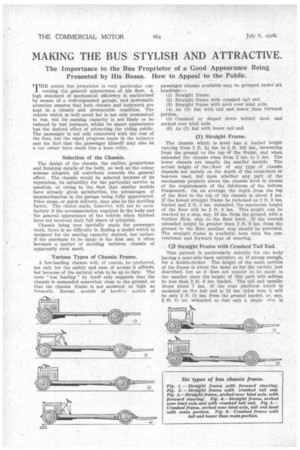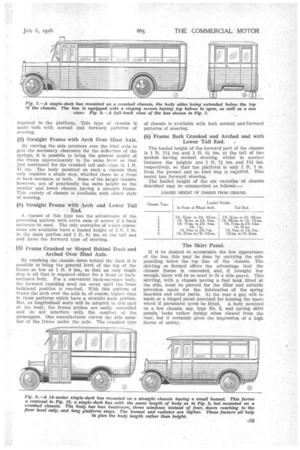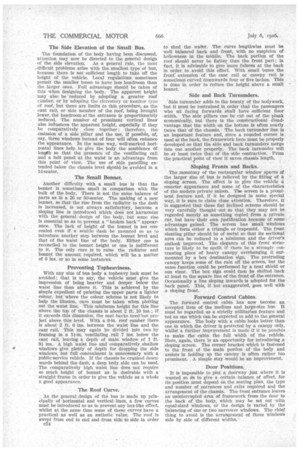MAKING THE BUS STYLISH AND ATTRACTIVE.
Page 42

Page 43

Page 44

If you've noticed an error in this article please click here to report it so we can fix it.
The Importance to the Bus Proprietor of a Good Appearance Being Presented by His Buses. How to Appeal to the Public.
TIIE astute bus proprietor is very particular concerning the general appearance of his fleet. A. high standard of mechanical efficiency is maintained by means of a well-organized garage, and systematic attention ensures that both chassis and bodywork are kept in .a cleanly and presentable condition. The vehicle which is well cared for is not only economical to run, but its earning capacity is not likely to be reduced by lost journeys, whilst its smart appearance has the desired effect of attracting the riding public. The passenger is not only concerned with the cost of the fare, but the rapid progress made in the industry and the fact that the passenger himself may also be a ear owner have made him a keen critic.
Selection of the Chassis.
The design of the chassis, the outline, proportions and finishing details of the body, as well as the colour scheme adopted, all contribute towards the general effect. The chassis would be selected because of its reputation, its suitability for the particular service in question, or owing to the faet that similar models have already given satisfaction, the advantages of standardization in the garage' being fully appreciated. Price alone, or quick delivery, may also be the deciding factor. The choice made, however, will not be satisfactory if the accommodation required in the body and the general appearance of the vehicle when finished have not received their full share of attention.
Chassis being now specially made for passenger work, there is no difficulty in finding a model which is designed for the seating capacity desired, but rather, if the purchase to be made is the first one, it often becomes a matter of deciding between chassis of apparently even merit.
Various Types of Chassis Frame.
A low-loading chassis will, of course, be preferred, not only for the safety and ease of access it affords, but because of the natural wish to be up to date. The term "low loading" by itself only suggests that the chassis is suspended somewhat close to the ground, or that the chassis frame is not mounted , so high as formerly. Recent models of leadini makes of passenger chassis available may be grouped under' six headings :— (1) Straight frame.
(2) Straight frame with cranked tail end.
(3) Straight frame with arch over hind axle.
(4) As (3) but with tail end lower than forward portion. (5) Cranked or sloped down behind dash and arched over hind axle.
(6) As (5) but with lower tail end.
(1) Straight Frame.
The chassis which is level has a loaded height varying from 2 ft. 3i ins. to 2 ft. 101 ins., measuring from the ground to the top of the frame, and when unloaded the chassis rises from 2 ins. to 5 ins. The lower chassis are usually the smaller models. The actual height of theifloor of any type of chassis depends not merely on the depth of the cross-bars or, bearers used, but upon whether any part of the mechanism Projects above the chassis level in excess of the requirements of the thickness of the bottom framework. On an average, the depth from the top of the floor to the top of the chassis is about 3 ins. If the lowest straight frame be reckoned as 2 ft. 3 ins. loaded and 2 ft. 5 ins, unloaded, the maximum height of the floor will be 2 ft. 8 ins. This height can be reached by a step, say, 16 ins, from the ground, with a further /6-in, step to the floor level. If the overall unloaded height be greater than 2 ft. 8 ins, from the ground to the floor another step should be provided. The straight frame is available both with the conventional and forward type of steering.
(2) Straight Frame with Cranked Tail End.
This pattern is particularly suitable for the body having a near-side back entrance, or, if strong enough, for a double-decker. The height of the main portion of the frame is about the same as for the variety just described, but as it does not appear to be made inthe smaller sizes the height of this part will seldom be less than 2 ft. 6 ins. loaded. The tail end usually drops about 7 ins. If the rear platform which is mounted on tte tail end is 21 ins, thick then it will he only 2 ft. 11 ins, from the ground loaded, or. say, 2 ft. 41_t ina unloaded, so that only a single step is required to the platform. This type of chassis is made both with normal and forward patterns of steering.
(3) Straight Frame with Arch Over Hind Axle.
By curving the side members over the hind axle to give the necessary clearance for the deflection of the springs, it is possible to bring the general height of the frame approximately to the same level as that just mentioned for the cranked tail end—that is, 1 ft. 11 ins. The body mounted on such a chassis then only requires a single step, whether there be a front or back entrance, or both. Some of the larger chassis, however, are of practically the same height as the smaller and lower chassis having a straight frame. This variety of chassis is available with either style of steering.
(4) Straight Frame with Arch and Lower Tail End.
A chassis of this type has the advantages of the preceding pattern with extra ease of access if a back entrance be used. The only -examples of which dimensions are available have a loaded height of 2 ft. 1 in. in the main portionand 1 ft. Si ins, at the tail end and have, the forward type of steering.
(5) Frame Cranked or Sloped Behind Dash and , Arched Over Hind Axle.
By cranking the chassis down behind the dash it is possible to bring the general level of the top of the frame as low as 1 ft. 9 ins., so that an easy single step is all that is required either for a front or backentrance body. For a convenient back-entrance body, the forward cranking need not occur until the front bulkhead position is reached. With this pattern of frame the arch over the axle is, of course, higher than in those patterns which have a straight main portion. But, as longitudinal seats will be adopted in this part of the body, theframe arches are easily concealed and do not interfere with the comfort of the passengers. One manufacturer curves the side member of the frame under the axle. The cranked type
of chassis is available with both normal and forward patterns of steering.
(6) Frame Both Cranked and Arched and with ' Lower Tail End.
The loaded height of the forward part of the chassis is 1 'Tt. 111 ins. and 1 ft. 6i ins, at the tail of two models having normal steering, whilst in another instance the heights are 1 ft. Ti ins. and 111 ins. respectively, so that the platform is only 1 ft. 1 in. from the ground and no hind step is required. This model has forward steering.
The loaned height of the six varieties of chassis described may be summarized as follows:— If it be desired to accentuate the low appearance of th,e bus, this may be done by carrying the side panelling below the top line of the chassis. The skirting so formed offers the advantage that the
chassis frame is concealed, and, if brought low enough, there will be no need to fit a side guard. This skirting, with a chassis having a fuel tank fitted at the side, must be pierced for the filler and suitable provision made for the lubrication of the spring shackles and other parts. At the rear a gap win be made or a hinged panel provided for housing the spare wheel if pneumatic tyres be fitted. A. body mounted on a low chassis, say, type No. 5, and having skirt panels, looks rather dumpy when viewed from the rear, but it certainly gives the impression of a high factor of safety.
The Side Elevation of the Small Bus.
The foundation of the body having been discussed, attention may now be directed to the general design of the side elevation. As a general rule, the most
-difficult problems arise with the smallest type of bus, because there Is not sufficient length to take off the height of the vehicle. Local regulations sometimes permit the smaller buses to have less headroom than the larger ones. Full advantage should be taken of this when designing the body. The apparent height may also be 'reduced by adopting a greater roof camber, or by adopting the clerestory or monitor type of roof, but there are limits to this procedure, as the cant rail, or side member of the roof, being brought lower, the headroom at the entrance is proportionately reduced. The number of prominent vertical lines also influences the apparent' height, especially if they be comparatively close together ; therefore, the omission of a side pillar and the use, if possible, of, say, three windows instead of four will often enhance the appearance. In the same way, well-marked horizontal lines help to give the body the semblance of length so that the presence of the ventilating rail and a belt panel at the waist is an advantage from this point of view. The use of side panelling extended below the chassis level should be avoided in a 14-seater.
The Small Bonnet.
Another difficulty with a small bus is that the bonnet is sometimes small in comparison with the bulk of the body. There is not the same balance of parts as in a 26 or 30-seater. The making of a new bonnet, so that the rise from the radiator to the dash is increased, is not always satisfactory, because a sloping line is introduced which does not harmonize with the general design of the body, but some rise is essential so as to prevent a "broken back " appearance. The lack of height of the bonnet is not concealed even if a scuttle dash be mounted so as to introduce another step between the bonnet level and that of the waist line of the body. Either one is reconciled to the bonnet height or one is indifferent to it. The only cure is to raise the radiator and bonnet the amount required, which will be a matter of 6 ins, or so in some instances.
Preventing Topheaviness.
With any size of bus body a topheavy look must be
• avoided ; that is to say, the vehicle must give the impression of being heavier and deeper below the waist line than above it. This is achieved by the simple expedient of painting the upper parts a lighter colour, but where the colour scheme is not likely to help the illusion, care must be taken when plotting out the waist line. This minimum height for this line above the top of the chassis is about 2 ft. 10 ins.; if it exceeds this dimension, the seat backs need 'not project above this level. With a 6-in, roof camber there is about 2 ft. 6 ins, between the waist line and the cant rail. This may again be divided into two by framing in a Win, ventilating rail 7 ins below the cant rail, leaving a depth of main window of 1 ft. 9* ins. A high waist line and comparatively shallow windows give plenty of depth for dropping the side windows, but full concealment is unnecessary with a public-service vehicle. If the chassis be cranked downwards behind the dash, a deep body side can be used. The comparatively high waist line does not require so much height of bonnet as is desirable with a straight frame in order to give the vehicle as a whole a good appearance.
The Roof Curve.
As the general design of the bus is made up principally of horizontal and vertical• lines, a few curves must be introduced so as to prevent any box-like effect, whilst at the same time some of these curves have a practical as well as an testhetic value. The roof is swept from end to end and from side to side in order e54
to shed the water. The curve lengthwise must be well balanced back and front, with no suspicion of hollowness in the middle. The back portion of the roof should never be flatter than the front part; in fart, it is advisable to give morefulness at the back in order to avoid this effect. With small buses the front' extension of the cant rail or canopy rail is sometimes curved downwards four or five inches. This is done in order to reduce the height above a small bonnet.
Side and Back Turnunders.
'Side turnunder adds to the beauty of the bodywork, but it must be restrained in order that the passengers who sit facing forwards shall have sufficient floor • width. The side pillars can be cut out of the plank economically, but there is the constructional _disadvantage that the width on the bottom is often nearly twice that of the chassis. The back turnunder line is . an important feature and, since a rounded corner is used at the back, the framework here must be properly developed so that the side and back turnunders merge into one another properly. The back turnunder will be at least twice that of the side contraction. From the practical point of view it saves chassis length.
Sloping Fronts and Backs.
The monotony of the rectangular window spaces of the larger size of bus is relieved by the fitting of a sloping screen. The effect is to give the vehicle a smarter appearance and some of the characteristics of the modern private saloon. Ttie screen is a prominent feature and, if it be designed in some special way, it is sure to claim close attention. Therefore, it is suggested that these flat inclined screens should be very carefully thought out so that they may not be regarded merely as something copied from a. private car, but have their own justification because of some advantage gained. The screen has small windows which form either a triangle or trapezoid. The front slanting pillar should be of metal so that its sectional area can be reduced to a minimum and the driver's outlook improved. The elegance of this front structure is likely to be spoilt if there be a strongly contrasting piece of heavy canopy overhanging it surmounted by a box destination sign. The protruding canopy keeps some of the rain off the screen, but the same function could be performed by a neat shield or sun vizor. The box sign could then be shifted back at least to the square line of the front of the entrance. Occasionally a line sloping inwards is adopted for the back panel. This, if not exaggerated, goes well with a sloping front.
Forward Control Cabins.
The forward control cabin has now become an accepted item of the medium and large-size bus. It must be regarded as a strictly utilitarian feature and not as one which can be expected to add to the general appearance. The body with a cabin looks better than one in which the driver is protected by a canopy only, whilst a further improvement is made if it be possible to make the cabin the full width of the vehicle. Here, again, there is an opportunity for introducing a sloping screen. The corner bracket which is fastened to the front of the main portion of the body and assists in holding up the canopy is often rather too prominent. A simple stay would be an improvement.
Door Positions.
It is impossible to plot a doorway just where it is wanted so as to give a certain balance of effect, for its position must depend on the seating plan, the type and number of entrances and exits required and the arrangement of the chassis. The front entrance leaves an uninterrupted area of framework from the door to the back of the body, which may be set out with equal-sized windows, or the design is varied by the balancing of one or two narrower windows. The chief thing to avoid is the arrangement of three windows side by side of different widths.
















































